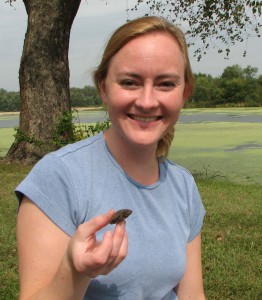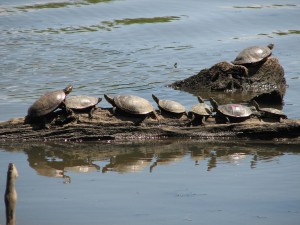
A new paper published in BMC Ecology today asks whether climate change could bias the sex ratio of certain reptiles, leading to potential extinction risk. In this guest blog, Lisa Schwanz, one of the authors, describes what they found.
As humans, we take for granted that roughly equal numbers of sons and daughters will be born into our populations every year. But, have you ever considered what problems would arise if we started producing 75% sons? Or 90% daughters?
While this is just a thought experiment for humans, it’s a reality for many reptile species around the world whose sex ratios are linked to climate. For most turtles and many lizards, the sex of an individual is determined during embryonic development by egg incubation temperature – a trait known as temperature-dependent sex determination. The contrasting system in mammals, birds, and other reptiles involves sex chromosomes (e.g. female XX and male XY), and is relatively insensitive to temperature.
The strong tie between temperature and individual sex in reptile species has led to concern that climate, and climate change, could bias the sex ratio of the entire offspring cohort and increase extinction risk.
For turtles, 100% females can hatch in warm years and 100% males in cold years. There is an unusual reptile in New Zealand, called the tuatara, that shows the opposite pattern, where males are produced at warm temperatures and females at cold temperatures. A large number of lizard species will only develop as a male at intermediate temperatures, and as a female at either extreme.
Due to a dearth of empirical data in the literature, we performed computer simulations to address this question, with the aim of gaining insight into fundamental processes that might operate in any species, rather than placing the focus on a single species.

Importantly, we knew that the impact of climate on population persistence would depend crucially on two factors – how biased the sex ratios are and what proportion of males is necessary for females in a population to reproduce. The number of females in a population is crucial for persistence since it puts a limit on how many offspring can be produced. Intuitively, a female-biased sex ratio can aid in population persistence as long as the mating system is polygamous and there are ‘just enough’ males to fertilize all of the females.
For the sake of comparison, we contrasted our results for temperature-sensitive species to those for species without temperature-driven sex ratios (i.e. with sex chromosomes). For species without temperature-driven sex ratios, we found that the geographic range is limited purely by the effects of climate on the ability of an embryo (i.e. egg) to survive and hatch. Where enough juveniles recruit into the population to replace dying adults, populations will persist.
In contrast, the range limits for a species whose sex ratios are driven by temperature were greatly reduced by the effect of climate. At the range edges, eggs can hatch sufficiently well, but too few males or too few females are produced to sustain future generations.
Populations don’t exist in isolation, however. They are connected to other populations through dispersal. And dispersal can bring an immigrant of the ‘rare’ sex.
As soon as we add dispersal, the predictions of our model change in a dramatic fashion. Importantly, species with temperature-driven sex ratios push their range boundaries to greater climatic extremes than species without biased sex ratios, as long as the rare sex immigrates to the biased populations at the range boundary.

To understand why this happens, consider a very warm population of a reptile without temperature-driven sex ratios. Most of the eggs die from overheating, and those eggs that do hatch are 50% males and 50% female. Not enough females hatch to become adults and sustain the population. Immigration can help support a few populations, but not many.
Now consider a population with temperature-driven sex ratios at the same warm climate. Similarly, only a small number of eggs hatch, but now all of the offspring are females. This means twice as many females hatch in a warm population if sex ratios are driven by climate compared to if they are not. This is a problem if there are no males to mate with. But add in the possibility of males dispersing from the colder part of the range, and you have enough reproductively-competent females to sustain the population.
Overall, when males disperse from their population or origin, the geographic range of species with temperature-driven sex ratios shifts into relatively warm (female-producing) climates. In contrast, when females disperse, the range shifts to relatively cold (male-producing) climates.
This might be good news for the majority of reptile species facing climatic warming. Most species with temperature-driven sex ratios overproduce females at warm temperatures and have male-biased dispersal. As long as some populations produce sufficient sons to disperse across the range, some populations may thrive under a warming climate.
Our next step in this research is to address this very question – how do climate-driven sex ratios influence the rate at which populations grow or decline under warming climates? The result will tell us whether reptiles with temperature-driven sex ratios are more vulnerable to climatic warming, or whether they have an advantage over their cousins with 50:50 sex ratios.
Lisa Schwanz is a Senior Lecturer and holds an ARC Discovery Early Career Researcher Award in the School of Biological, Earth and Environmental Sciences and Evolution & Ecology Research Centre at the University of New South Wales.
Comments